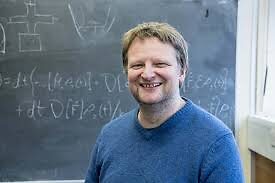QSense OIST Mini-Symposium Talk 5: Probing new physics by levitated mechanical systems

Date
Location
Description
Speaker: Prof Hendrik Ulbricht, Department of Physics and Astronomy, University of Southampton
Probing new physics by levitated mechanical systems
(QSense OIST Mini Symposium Talk 5)
I will report on our recent progress with levitated experiments, especially with Meissner levitated ferromagnets above a type-1 superconductor. We find a system with ultralow mechanical damping showing great potential for sensing tiny forces [1] and, interestingly, independent from the standard quantum limit - which holds promise to detect record low magnetic fields and we discuss ideas for a ferromagnetic gyroscope [2], where the precession motional degree of freedom is used to sense tiny magnetic fields. We also discuss how other rotational degrees of freedom can be used for inertial and force detection. We apply force noise measurements to bound collapse models to test the quantum superposition principle in the macroscopic domain of large mass systems [3, 4]. We illustrate ideas to used levitated mechanical systems to probe into gravity interactions leading toward the experimental exploration of the interplay between quantum mechanics and gravity [5]. We also mention ideas to probe into the physics of quantum field theory effects in non-inertial reference frames based on spinning micro-particles [6, 7].
[1] Vinante, A., P. Falferi, G. Gasbarri, A. Setter, C. Timberlake, and H. Ulbricht, Ultrahigh mechanical quality factor with Meissner-levitated ferromagnetic microparticles, Phys. Rev. Appl. 13, 064027 (2020) with Editor's Suggestion, and arXiv:1912.12252.
[2] Fadeev, P., C. Timberlake, T. Wang, A. Vinante, Y. B. Band, D. Budker, A. O. Sushkov, H. Ulbricht, and D. F. J. Kimball Ferromagnetic Gyroscopes for Tests of Fundamental Physics, arXiv:2010.08731 (2020).
[3] Vinante, A., M. Carlesso, A. Bassi, A. Chiasera, S. Varas, P. Falferi, B. Margesin, R. Mezzena, and H. Ulbricht, Narrowing the parameter space of collapse models with ultracold layered force sensors, Phys. Rev. Lett. 125, 100404 (2020), and arXiv:2002.09782.
[4] Vinante, A., G. Gasbarri, C. Timberlake, M. Toroš, and H. Ulbricht, Testing Dissipative Collapse Models with a Levitated Micromagnet, Phys. Rev. Research 2, 043229 (2020) with Editor's suggestion, and arXiv:2008.06245.
[5] Carlesso, M., A. Bassi, M. Paternostro, and H. Ulbricht, Testing the gravitational field generated by a quantum superposition, New J. Phys. 21 093052 (2019), and arXiv:1906.04513.
[6] Braidotti, M. C., A. Vinante, G. Gasbarri, D. Faccio, and H. Ulbricht, Zel'dovich amplification in a superconducting circuit, Phys. Rev. Lett. 125, 140801 (2020), and arXiv:2005.03705.
[7] Lochan, K., H. Ulbricht, A. Vinante, S. K. Goyal, Detecting acceleration-enhanced vacuum fluctuations with atoms inside a cavity, Phys. Rev. Lett. 125, 241301 (2020), and arXiv:1909.09396.
OIST Mini-Symposium for Quantum Sensors of Magnetic and Inertial Forces
This mini-symposium is hosted by the Quantum Machines Unit in the Okinawa Institute of Science and Technology Graduate University, and will take place from Feb 1, 2021 - March 5, 2021. To get the precise schedule and zoom invitation please register below. Attendance is open to any student/faculty member from any of the institutions associated with the speakers.
Summary
Quantum systems are extremely fragile, sensitive to noise and fluctuations by their environments. This, in turn, makes them excellent sensors for a variety of forces and fields. In this mini-symposium we focus on the development of novel quantum sensors which are aimed at the precision sensing of inertial forces such as acceleration or gravity, and magnetic forces.
Such sensors - accelerometers/gravimeters or magnetometers, have a widespread application in industry such as sensing underground water movements using gravimeters, through to magnetic brain imaging using magnetoencephelography. Each week we hear from three international experts on these topics in hour-long seminars and discussions.
For more information, visit the QSense website.
Website URL
Subscribe to the OIST Calendar: Right-click to download, then open in your calendar application.



